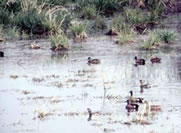Habitats:
Post Oak Savannah
Waterfowl and Wetland Management in the Post Oak Savannah

Texas is considered the most important wintering area for migratory waterfowl in the Central Flyway. An estimated 3 to 5 million birds rely on Texas' wetlands for winter habitat each year. Also, wetlands provide important habitat for more than 50% of the country's migratory bird species.
In Texas, wetlands are among the most rare and declining resources in the state. Once covering several thousands of acres, it is now estimated that over half of Texas' wetlands have been lost. Major causes for this astounding reduction are:
- Reservoir Development
- Urban Development (Industrial and residential),
- Agriculture (Levied off areas along major creeks and rivers),
- Deforestation.
Wetlands are areas that contain water or saturated soil for a significant part of the year, exhibit a plant community dominated by species adapted to wet environments (hydrophytic vegetation), and have soil conditions formed by frequent flooding (hydric soils). In East Texas, wetlands can be found in the forms of swamps, springs, seeps, bogs, and bottomland hardwood forest.
Wetlands are considered to be nature's filters. These dynamic ecosystems have the ability to improve surface water quality by filtering out pollutants and sediment, prevent or minimize flooding, replenish groundwater, and provide habitat for numerous species of resident and migratory wildlife.
Wetlands are not only important ecologically, but they also provide substantial economic benefits as well. Recreational activities abound in and around wetlands and provide for a multi-billion dollar hunting, fishing, and outdoor recreational industry nationwide. From a private land standpoint, wetlands can provide income through waterfowl hunting, fishing, and bird watching, to name a few.
To address the issue of the reduction of wetland habitat in Texas, government agencies and private organizations have come together to offer several incentive programs for private landowners to create or enhance wetlands on their property. These incentive programs are typically cost-shared in nature. This means that the sponsoring agency or organization will help the landowner by paying a portion of the cost (typically ½ to 2/3) to implement the conservation practices.
Links to other Waterfowl and Wetland Conservation pages can be found on the sidebar.
 (
(